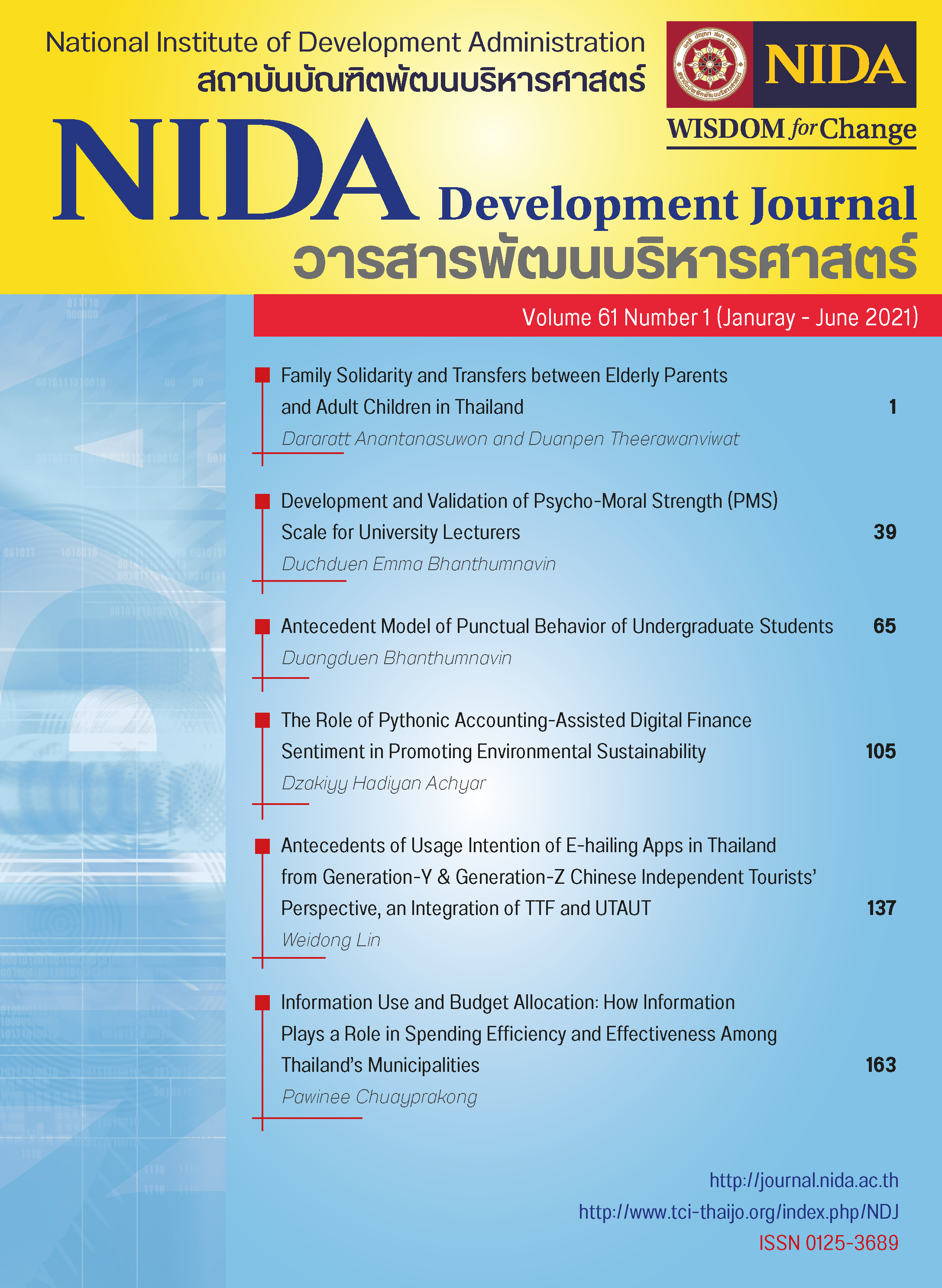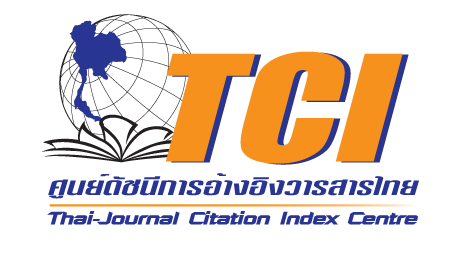Development and Validation of Psycho-Moral Strength (PMS) Scale For University Lecturers
Keywords:
Psychological Scale, Factor Analysis, Academic BehaviorAbstract
This study aims at constructing psycho-moral strength scale (PMS) which consisted of four important psychological characteristics, namely, 1) need for achievement, 2) internal locus of control, 3) future orientation and self-control, and 4) moral identity. These four factors were derived from the Thai psychological theory of moral and work behavior which has been strongly confirmed by empirical data. In the first phase with the total of 700 university lecturers, four-factor model emerged from exploratory factor analysis which could explain the variance for 55.16%. The confirmatory factor analysis indicated the fit model. In the second phase, validation in terms of incremental validity using hierarchical regression analysis on academic exploring and exploiting behavior of 128 university lecturers revealed that psycho-moral strength significantly yielded the predictive percentage beyond core self-evaluation (CSE) and psychological capital (PsyCap) with 22.80%. In addition, the magnitude of the psycho-moral strength was significantly higher in the more academically successful lecturers. Furthermore, PMS showed stronger relation with CSE (r = 0.604, p<.01) than PsyCap (r = 0.399, p<.01). These results lead to a new approach for future research, intervention, and assessment to enhance desired behaviors.
References
Ajzen, I. (1991). The Theory of Planned Behavior. Organizational Behavior and Human Decision Processes. 50: 179-211.
Ajzen, I. & Fishbein, M. (1980). Understanding Attitudes and Predicting Social Behavior. Englewood, NJ: Prentice-Hall.
Aquino, K., & Reed, II, A. (2002). The self-Importance of Moral Identity. Journal of Personality and Social Psychology. 83(6): 1423-1440.
Bandura, A. (1982). Self-Efficacy Mechanism in Human Agency. American Psychologist. 37(2): 122–147.
Bandura, A. (1986). Social Foundations of Thought and Action: A Social Cognitive Theory. Prentice-Hall, Inc.
Bandura, A. (2002). Selective Moral Disengagement in The Exercise of Moral Agency. Journal of Moral Education. 31(2): 101–119.
Barratt, J. M., & Duran, F. (2021). Does Psychological Capital and Social Support Impact Engagement and Burnout in Online Distance Learning Students? Internet and Higher Education. 51:100821.
Bentler, P. M. (1990). Comparative Fit Indexes in Structural Models. Psychological Bulletin. 107(2): 238–246.
Bhanthumnavin, D.L. (1983). Moral Socialization of Teacher [ In Thai]. Monograph No.4. Behavioral Science Research Institute, Srinakhariwirot University.
Bhanthumnavin, D.L. (1995). The Thai Psychological Theory of Moral and Work Behavior. The Graduate School of Social Development, National Institute of Development Administration.
Bhanrhumnavin,D.L., & Bhanthumnavin, D.E. (2021). Academic Innovative Tales and the Enhancement of Psycho-moral Strength in Students. Warasan Phuettikammasat. 27(1): 1-17.
Bhanthumnavin, D.E. 2018. Acadamic Inculcalting Behavior Scale and Validation using CSE and PsyCap in Diverse Faculty Members. International Journal of Engineering & Technology. 7(4.38):1323-1326.
Bhanthumnavin, D.E. (2015). Antecedents of Readiness and Potential to Become Researchers in Different types of Individuals: Researchers. Under research project “Multi-Causal Factors of Readiness and Potentials to Become Researchers in University Students, and Thai Scholars”. Funded by 2014 Government Budget Grant. National Institute of Development Administration.
Bhanthumnavin, D.E. (2022). Empirical construction of measures of psychological characteristics and training efficiency on psycho-moral strength of learners and their validation in Thai university lecturers. Under research program “Psycho-moral strength in research and training of lecturers for students’ development” [2017 Grant]. The Graduate School of Social Development and Strategic Management, National Institute of Development Administration.
Bhanthumnavin, D.E., & Bhanthumnavin, V. (2014). The Empirical Development of Cognitive, Affective, and Behavioral Tendency Measures of Attitudes Toward Nuclear Power Plants in Thai University Students. Progress in Nuclear Energy. 73: 86-95.
Boies, K., Lee, K., Ashton, M. C., Pascal, S., & Nicol, A. A. M. (2001). The Structure of the French Personality Lexicon. European Journal of Personality. 15: 277–295.
Browne, M. W., & Cudeck, R. (1993). Alternative Ways of Assessing Model Fit. In K. A. Bollen and J. S. Long (Eds.), Testing Structural Equation Models (pp. 136-162). Newbury Park, CA: Sage.
Brutus, S., Aguinis, H., & Wassmer, U. (2012). Self-Reported Limitations and Future Directions in Scholarly Reports: Analysis and Recommendations. Journal of Management. 39(1): 48-75.
Cattell, R. B. (1943). The Description of Personality: Basic Traits Resolved into Clusters. Journal of Abnormal and Social Psychology. 38: 476-506.
Coke, J. S., Batson, C. D., & McDavis, K. (1978). Empathic Mediation of Helping: A Two-stage Model. Journal of Personality and Social Psychology. 36(7): 752–766.
Davis, F. (1989) Perceived Usefulness, Perceived Ease of Use, and User Acceptance of Information Technology. MIS Quarterly. 13: 319-340.
de Volder, M. L., & Lens, W. (1982). Academic Achievement and Future Time Perspective as A Cognitive–Motivational Concept. Journal of Personality and Social Psychology. 42(3): 566–571.
Di Blas, L., & Forzi, M. (1998). An Alternative Taxonomic Study of Personality Descriptive Adjectives in The Italian Language. European Journal of Personality. 12: 75–101.
Gibbons, E., Stein, C., Springer, J., Roemhild, E., Meadows, E., & Dowling, J. (in press). Knowledge, Attitudes, and Beliefs of Pediatric Health Care Workers: Understanding the Response to COVID-19. Journal of Pediatric Health Care. xx, xxx-xxx.
Goldberg, L. R. (1981). Language and Individual Differences: The Search for Universals in Personality Lexicons. In L. Wheeler (Ed.), Review of Personality and Social Psychology, (Vol. 2, pp. 141- 165). Beverly Hills, CA: Sage.
Goldberg, L. R., & Somer, O. (2000). The Hierarchical Structure of Common Turkish Person-Descriptive Adjectives. European Journal of Personality. 14: 497–531.
Gou, M.S., Webb, T.L., & Prescott, T. (2021). The Effect of Direct and Extended Contact on Attitudes Towards Social Robots. Heliyon. 7(3): e06418.
Fang,X., Qu,Z., Sun,C., Wu,C., & Wei, J. (2022). Public Attitude and Policy Selection of Future Energy Sustainability in China: Evidence of The Survey of The College Students. Energy Policy.165: 112961.
Hahn, D.W., Lee, K., & Ashton, M. C. (1999). A Factor Analysis of The Most Frequently Used Korean Personality Trait Adjectives. European Journal of Personality. 13(4): 261–282.
Harter S. (1990). Causes, Correlates, and The Functional Role of Global Self-Worth: A Life Span Perspective. In RJ Sternberg & J Kolligan Jr (Eds.), Competence Considered (pp. 67-97). New Haven: Yale University Press.
Hermans, H. J. (1970). A Questionnaire Measure of Achievement Motivation. Journal of Applied Psychology. 54(4): 353–363.
Hu, L.T., & Bentler, P. M. (1998). Fit Indices in Covariance Structure Modeling: Sensitivity to Underparameterized Model Misspecification. Psychological Methods. 3(4): 424–453.
Kraiprasit, T., Bhanthumnavin, D.L., & Bhanthumnavin, D.E. (2022). Psycho-Situational Predictors of Knowledge Exploring Behavior Among Teachers. Turkish Journal of Physiotherapy and Rehabilitation. 32(3): 41216-41230.
Liu, Y., Duan, Y., & Xu, L. (2020). Volunteer Service and Positive Attitudes Toward Aging Among Chinese Older Adults: The Mediating Role of Health. Social Science Medicine. 265: 113535.
Jarvis, C. B., MacKenzie, S. B., & Podsakoff, P. M. (2003). A Critical Review of Construct Indicators and Measurement Model Misspecification in Marketing and Consumer Research. Journal of Consumer Research. 30(2): 199–218.
John, O. P., & Srivastava, S. (1999). The Big Five Trait Taxonomy: History, Measurement, and Theoretical Perspectives. In L. A. Pervin & O. P. John (Eds.), Handbook of personality: Theory and research (pp. 102–138). Guilford Press.
Johnston, R. A. (1957). A Methodological Analysis of Several Revised Forms of The Iowa Picture Interpretation Test. Journal of Personality. 25: 283–293.
Joreskog, K. G., & Sorbom, D. (1996). LISREL8 User's Reference Guide. Mooresville Scientific Software.
Judge, T. A., & Bono, J. E. (2001). Relationship of Core Self-Evaluations Traits—Self-Esteem, Generalized Self-Efficacy, Locus of Control, and Emotional Stability—With Job Satisfaction and Job Performance: A Meta-Analysis. Journal of Applied Psychology. 86(1): 80–92.
Judge, T. A., Erez, A., & Bono, J. E. (1998). The Power of Being Positive: The Relationship Between Positive Self-Concept and Job Performance. Human Performance. 11: 167-187.
Judge, T. A., Erez, A., Bono, J. E., & Thoresen, C. J. (2003). The Core Self-Evaluations Scale: Development of A Measure. Personnel Psychology. 56: 303–331.
Judge, T. A., Locke, E. A., & Durham, C. C. (1997). The Dispositional Causes of Job Satisfaction: A Core Evaluations Approach. Research in Organizational Behavior. 19: 151-188.
Kohlberg, L. (1974) Education, Moral Development and Faith. Journal of Moral Education. 4(1): 5-16.
Krech, D., Crutchfield, R. S., & Ballachey, E. L. (1962). Individual in society: A textbook of social psychology. McGraw-Hill.
Krueger, R. F., & Tackett, J. L. (2003). Personality and Psychopathology: Working Toward The Bigger Picture. Journal of Personality Disorders. 17: 109–128.
Kumar,D., Upadhyay, Y., Yadav, R., & Goyal, A.K. (2022). Psychological Capital and Innovative Work Behaviour: The Role of Mastery Orientation and Creative Self-Efficacy. International Journal of Hospitality Management. 102:103157.
Locke, E.A., McClear, K., & Knight, D. (1996). Self-Esteem and Work. International Review of Industrial/Organizational Psychology. 11: 1-32.
Luthans, F., Avolio, B.J., Avey, J.B., & Norman, S.M. (2007). Positive Psychological Capital: Measurement and Relationship With Performance and Satisfaction. Personnel Psychology. 60: 541–72.
Luthans, F., & Youssef, C.M. (2004). Human, Social, and Now Positive Psychological Capital Management: Investing in People for Competitive Advantage. Organizational Dynamic. 33:143–60.
Luthans, F. (2002). Positive Organizational Behavior: Developing and Managing Psychological Strengths. The Academy of Management Executive. 6: 57–72.
Luo, C.Y., Tsai, C.H., Su, C.H., Kim, H.J., Gao, J.L., & Chen, M.H. (2022). How Does Hotel Employees’ Psychological Capital Promote Adaptive Performance? The Role of Change Readiness. Journal of Hospitality and Tourism Management. 51: 491-501.
March, J.G. (1991). Exploration and Exploitation in Organizational Learning. Organization Science. 2(1): 71-87.
McClelland, D. (1965). Achievement Motivation Can Be Developed. Harvard Business Review. 43: 68.
McClelland, D. C., Atkinson, J. W., Clark, R. A., & Lowell, E. L. (1953). The Achievement Motive. Appleton-Century-Crofts.
McCrae, R. R., & Costa, P. T., Jr. (1997). Personality Trait Structure as A Human Universal. American Psychologist. 52(5): 509–516.
Mischel, W., (1974). Processes in Delay of Gratification. In: W. Misehel and L. Berkowitz (eds). Advances in experimental social psychology. New York: Academic Press. pp. 249-29.
Norman, W. T. (1963). Toward an Adequate Taxonomy of Personality Attributes: Replicated Factor Structure in Peer Nomination Personality Ratings. Journal of Abnormal & Social Psychology. 66: 574-583
Ostendorf, F. (1990). Language and Personality Structure: On the Validity of the Five Factor Model of Personality. Regensburg, Germany: S. Roderer Verlag.
Piaget, J. (1936). Origins of Intelligence in The Child. London: Routledge & Kegan Paul.
Piaget, J. (1971). The Theory of Stages in Cognitive Development. In D. Green, M. P. Ford, & G. B. Flamer (Eds.), Measurement and Piaget (pp. 1-11). New York, NY: McGraw-Hill.
Punpromthada, A., Bhanthumnavin, D.E., Bhanthumnavin, D.L., Meekun, K., Sitsira-at, S., Pimthong, S., & Yaemyuen, A. (2022). Preventing COVID-19 Spread at Home of Thai University Students Through Appropriate Psycho-Behavioral Model. Educational Sciences: Theory & Practice. 22(1): 101-115.
Rosenberg, M. (1979). Connecting The Self. New York: Basic Books.
Rotter, J. B. (1966). Generalized Expectancies for Internal Versus External Control of Reinforcement. Psychological Monographs: General and Applied. 80(1): 1–28.
Saucier, G. (1997). Effect of Variable Selection on The Factor Structure of Person Descriptors. Journal of Personality and Social Psychology. 73: 1296–1312.
Seligman, M.E.P., & Csikszentmihalyi, M. (2000). Positive Psychology. American Psychologists. 55: 5–14.
Sharma, P.K., &,Misra, R.K. (2017). Core Self Evaluations Scale: An Empirical Attestation Among Software Professionals. Procedia Computer Science. 122: 79-85.
Szirmak, Z., & De Raad, B. (1994). Taxonomy and Structure of Hungarian Personality Traits. European Journal of Personality. 8: 95–118.
Tucker, L. R., & Lewis, C. (1973). A Reliability Coefficient for Maximum Likelihood Factor Analysis. Psychometrika. 38(1): 1–10.
Watson D. (2000). Mood and Temperament. New York: Guilford Press.
Wu, W.Y., & Nguyen, K.V.H. (2019). The Antecedents and Consequences of Psychological Capital: A Meta-Analytic Approach. Leadership & Organization Development Journal. 40(4): 435-456.
Yang, K.S, & Bond, M. H. (1990). Exploring Implicit Personality Theories With Indigenous or Imported Constructs: The Chinese Case. Journal of Personality and Social Psychology. 58: 1087-1095.
Zigler, E. F., & Muenchow, S. (1992). Head Start: The Inside Story of America's Most Successful Educational Experiment. Basic Books.
Zigler, E., & Valentine, J. (1979). Project Head Start: A Legacy of the War on Poverty. The Free Press, New York.
Downloads
Published
How to Cite
Issue
Section
License
Copyright (c) 2023 NIDA Development Journal

This work is licensed under a Creative Commons Attribution-NonCommercial-NoDerivatives 4.0 International License.





